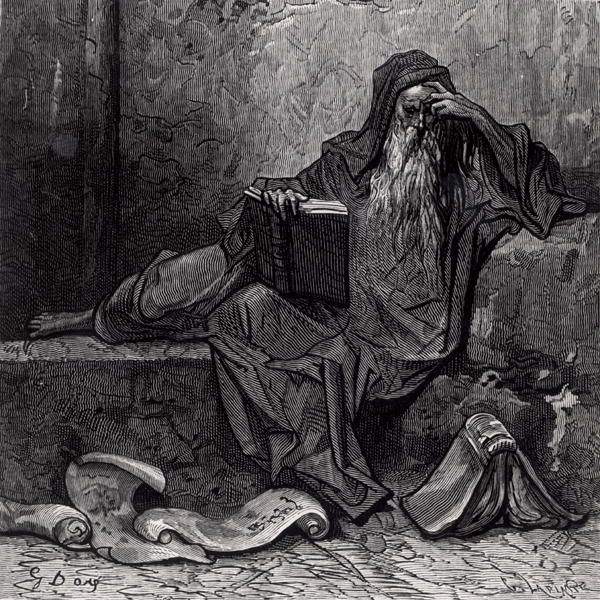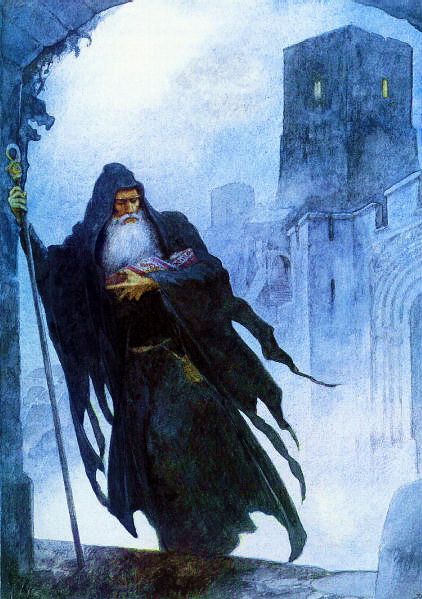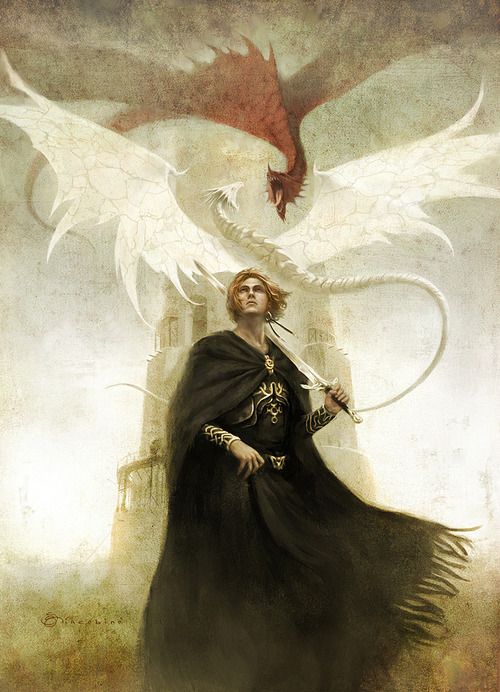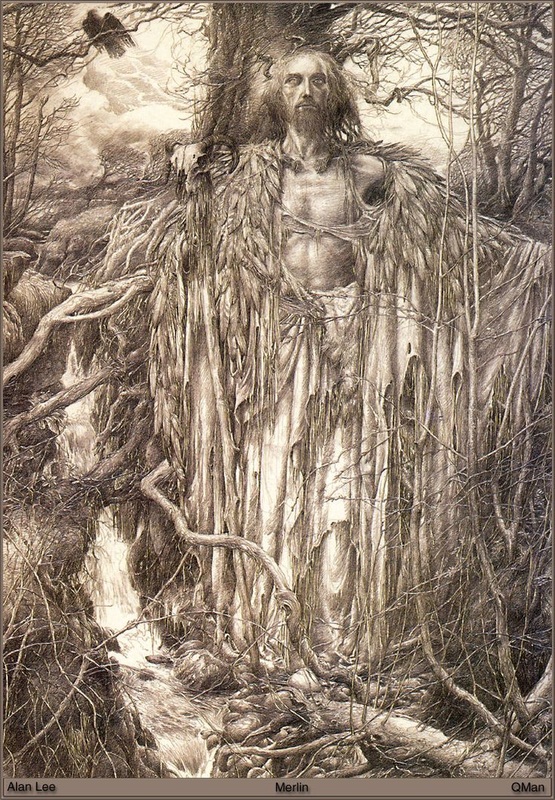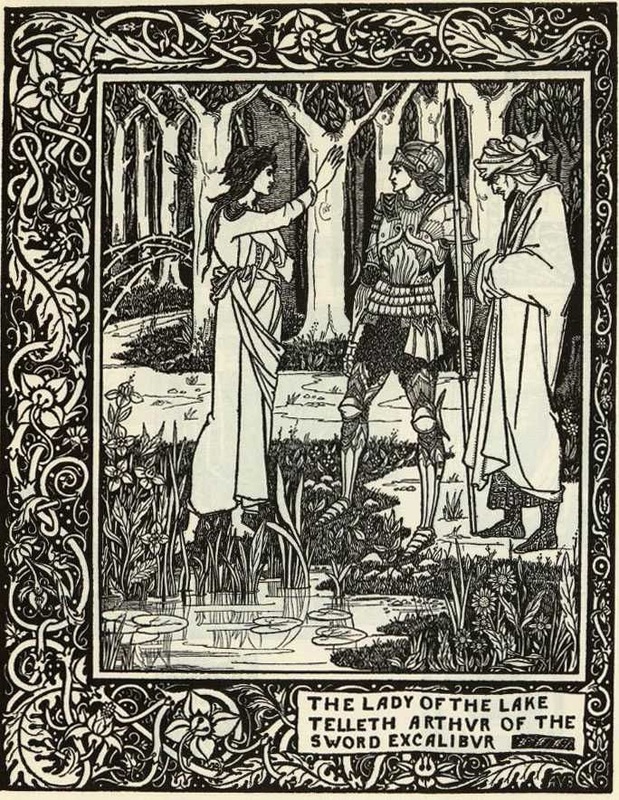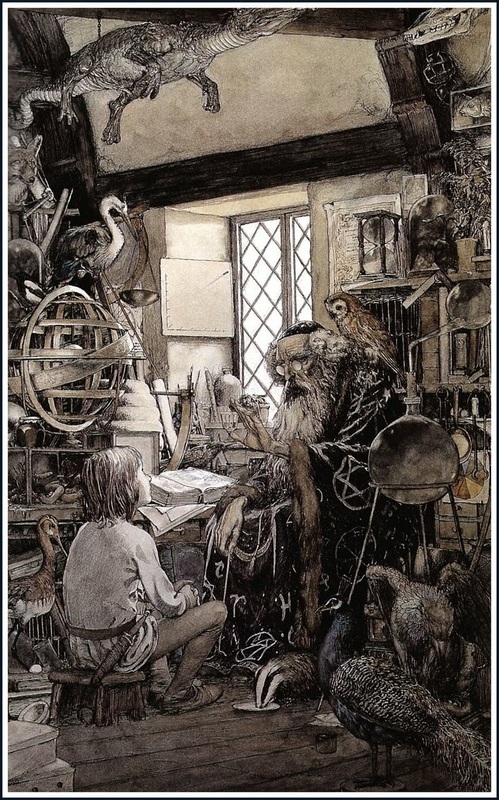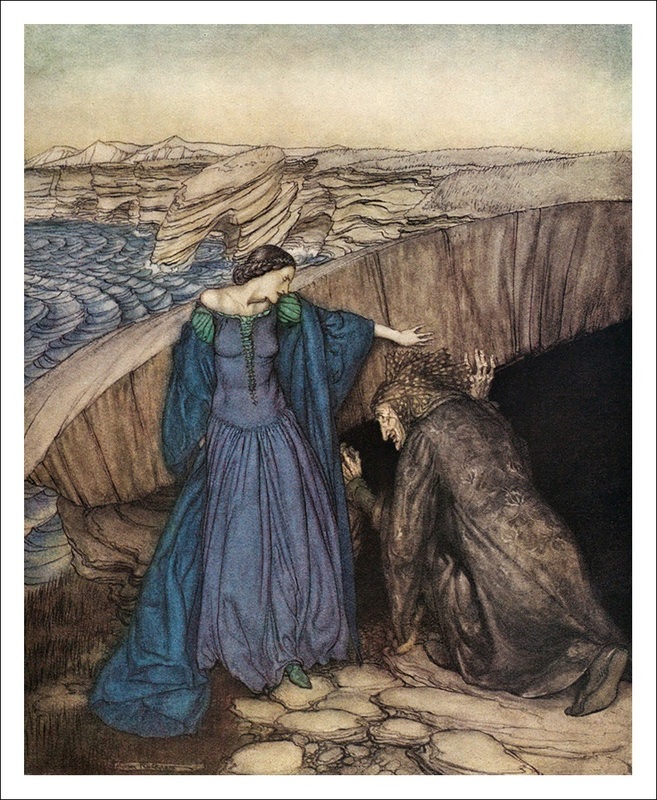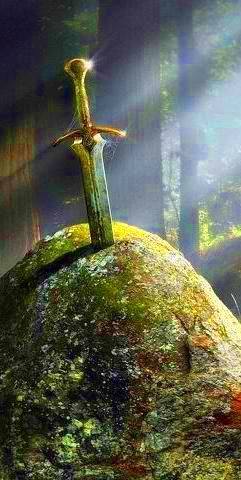|
An Overview of Merlin by Lori J. Fitzgerald-- @MedievalLit "He walked with dreams and darkness," Merlin and Vivien, Idylls of the King, Alfred Lord Tennyson The most shadowy and complex figure in Arthurian legend is Merlin, a composite not only of roles but of people, both historical and literary. Enchanter, political advisor, teacher, prophet, poet: Once Upon a Time has a plethora of characterization to choose from for its undoubtedly unique portrayal of the Sorcerer coming up in Season 5. The Apprentice’s reveal of the Sorcerer’s name in the Season 4 Finale was an enchanting moment; however, one thing that research has shown about this enigmatic wizard is that "Merlin" was probably not his real name. Names have power, as we know from Rumplestiltskin. The Ancient Celts believed that the name of a person and his soul were connected, and as thus, tied into power and control. Names should be kept hidden. The great Bard Taliesin formally forbade all teachers in the Celtic realm from revealing personal names, as they held the keys to the sacred stories. So "The Merlin" was probably either a nickname or a title. A merlin is a type of falcon, small, swift, and dark: a hunter of other birds. As such, it seems appropriate for a person who was powerful enough to be a Maker of Kings. Merlin is first seen in Geoffrey of Monmouth's Historia Regum Britanniae (The History of the Kings of Britain) and Vita Merlini (The Life of Merlin), which are "pseudo-histories” from the Early Middle Ages (circa 1100). A pseudo-history is a medieval account cobbled together of both documented information and folktale, and it usually focused on battlefield events and politics. Overall, in Geoffrey's works, Merlin is a nobleman and a warrior, chief political advisor to three kings, and Arthur’s standard bearer at the front of battle, as well as his army recruiter. This Merlin, who probably was an actual political leader and powerful lord, lived during the time of the historical chieftain Arthur, circa 450-536. But the seed of the enchanter was also planted by Geoffrey of Monmouth. In his works he recounts "The Prophesy of Merlin," which begins with Merlin's most famous prophesy: the birth of Arthur. Merlin tells the present king, Vortigern, the meaning of two fighting dragons, red and white. The red dragon represents the Britons and the white the Saxons. The red will be victorious for a while, through the "Boar of Cornwall," but in several generations the white will prevail. The Boar of Cornwall is the historical chieftain Arthur, who beat back the Saxons for generations with his great victory at the Battle of Mount Badon and led a period of peace for the Britons. Merlin goes on to prophesize a great many future events. Here Geoffrey seems to be overlapping the advisor Merlin with another figure: the Welsh poet Myrddin, who lived around 550 AD. (He does this especially in the Vita Merlini, which presents differing information about Merlin than the earlier Historia. Geoffrey may have embellished this second account with his own imagination as well as folklore. Once's Isaac Heller would be proud.) Myrddin was a bard in the service of one of the last great Celtic kings, Gwenddoleu of Arfderydd. Myrddin survived the Battle of Arderydd but reportedly went mad after his king was defeated and killed. He lived for a while as the "wild man of the woods" in the Caledonian forests of Scotland. Bards, the great poets of the Celtic realm, were esteemed and believed to wield poetic power through their words: they were the keepers of ancient lore, had the power to bless or curse with their songs, and were advisers and teachers of the nobility. It is fitting, then, that the Sorcerer/Merlin in Once Upon a Time has charged storybooks with power and bestows the role of Author. After his prophesy, Merlin enchants the megalithic bluestones of “The Giant’s Dance” all the way from Ireland to create a great mausoleum for the fallen kings of Britain on Salisbury Plain…yes, Stonehenge. (Obviously this is not the case; Geoffrey may have been recording an ancient tradition which connects to the original builders.) Merlin also arranges the conception of Arthur: he magically disguises Uther Pendragon to look like the husband of the Duchess of Cornwall, so he can lie with her and beget Arthur. All together, in Geoffrey of Monmouth’s accounts, Merlin is a great advisor and political machinator of kings, not only prophesying the future but molding it as well. The pseudo-histories bloomed into the great Arthurian romances, where not only battles were fought and won but hearts as well in courtly fashion. It is in the romances of the High and Late Middle Ages (1300-1500) that King Arthur’s Court flourishes, with the Knights of the Round Table questing for honor, love, and the Holy Grail. Merlin plays a big part in the Old French Vulgate Cycle, including the Prose Lancelot and the Prose Merlin, attributed to Robert de Boron. These are the manuscripts Sir Thomas Malory referenced, among others, when he created his own Le Morte D’Arthur (1470), the definitive collection of medieval Arthurian literature. In the medieval romance tradition, Merlin is teacher and tester as well as sorcerer, his magic being explained by demonic ancestry. He arranges the sword in the stone test for the rightful King of England (please see my previous Origins article for more information). He brings Arthur to the Lady of the Lake, to receive another enchanted sword, Excalibur: Then King Arthur looked on the sword and liked it passing well. “Which pleases you better, the sword or the scabbard?” said Merlyn. “The sword pleases me better,” said Arthur. “Ye are the more unwise,” said Merlyn, “for the scabbard is worth ten of the sword. While ye have the scabbard upon you, ye shall never lose any blood, be ye ever so sorely wounded. Therefore always keep the scabbard with you.” (Malory) Merlin is always teaching and testing, even the knights on their quests. Some scholars also point to evidence within the text of Sir Gawain and the Green Knight (circa 1350) that Bertilak, the Green Knight, is actually meant to be Merlin in disguise. Merlin often disguises himself as a child or a beggar on the road, in order to facilitate a test; in Once Upon a Time Season 4 the Sorcerer is a shadowy figure in a cavern, with only his voice revealed. The predominance of Merlin as teacher is best shown in the modern retelling The Once and Future King by T. H. White (1958), upon which the Disney movie The Sword in the Stone was based. She was afraid of him because he was a devil’s son, but she could not be rid of him by any means. So on a time it happened that Merlyn showed her where there was a great wonder wrought by enchantment under a huge stone. Then by her own subtle work she made Merlyn go under that stone to let her know about the marvels there. But she so wrought there that he never came out, for all the craft he could exert. So she departed and left Merlyn there. (Malory) (Other medieval romance sources relate that Merlin was not buried under stone but in a tree, an oak or hawthorn, and that Nimue deliberately seduced him to steal his magic and knowledge.) In Le Morte D’Arthur, Merlin is only present in the first four chapters. Once Arthur’s reign is established he is no longer needed. Malory accounts how Merlin “fell into dotage upon” one of the damosels of the Lady of the Lake, named Nymue, who eventually tricks him: This stone is Merlin’s cave; notice that it is never said that Merlin dies. Like Arthur, the “once and future king,” Merlin is made timeless and otherworldly, with the possibility of his return. In the San Diego Comic Con panel, Adam and Eddy made reference to Camelot existing in a parallel world to the Enchanted Forest, and mysteriously hinted at the possibility that it may also exist out of linear time, which would be incredibly fitting. As much as Merlin is a figure robed in magic and mystery, he is a symbol of strength through knowledge. He represents the enchantment of old ways and the timelessness of mythology. Like King Arthur, he also represents hope: the hope for peace and justice as brought by both the historical Arthur’s defeat of the Saxons and the code of King Arthur’s Court in the medieval romances. It will be interesting to see how Once Upon a Time integrates Merlin and his magic into its story about hope. Works Referenced Lori J. Fitzgerald is a Once Upon a Fan Staff Writer, former English teacher, and fantasy author. She holds a Master's Degree in English, specializing in medieval Arthurian literature.
For more pictures of Merlin, take a look at Lori's Pinterest Board Wizards and Bards: https://www.pinterest.com/whiteraven829/wizards-and-bards/ The following literature is recommended for further reading about Merlin. Please note that the medieval works are considered source material. More modern authors have put their own spin on the tales, much like the creators and writers of Once Upon a Time do. Historia Regum Britanniae (History of the Kings of Britain) by Geoffrey of Monmouth (1136) Vita Merlini (The Life of Merlin) by Geoffrey of Monmouth (c.1150) Le Morte D'Arthur by Sir Thomas Malory (1470) Merlin and Vivian from Idylls of the King by Alfred, Lord Tennyson (c. 1859) The Once and Future King by T. H. White (1958) The Merlin Trilogy (The Crystal Cave, The Hollow Hills, The Last Enchantment) by Mary Stewart (1970s) Works Referenced: Alcock, Leslie. Arthur's Britain. London: Penguin, 1971. Emerick, Carloyn. "The Myth of Merlin and the Man Behind the Legend." Circle Magazine, Issue 121 Bardic Pathways. Goodrich, Norma Lorre. Merlin. New York: Harper Collins: 1988. Loomis, Roger Sherman. Celtic Myth and Arthurian Romance. London: Constable, 1993. Matthews, John. The Arthurian Tradition. Great Britain: Element Books, 1994. Stewart, R.J. and Robin Williamson. Celtic Bards, Celtic Druids. United Kingdom: Blandford, 1996. All pictures are from Pinterest. If a picture is your work and you would not like it used in this article, please contact us.
1 Comment
Meredith Pechta
18/7/2015 12:47:08
When you know the name of the next episode, let us know.
Reply
Leave a Reply. |
OriginsExplore the Arthurian legend surrounding Lancelot, take a trip into the woods to discover the mythology behind Red Riding Hood or learn more about a modern day hero called Snow White. Origins provides unique insights and perspectives from talented writers into the characters we know and love, going far beyond the boundaries of Storybrooke. Archives
August 2016
Categories
All
|
